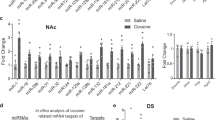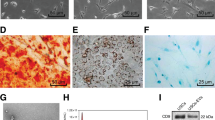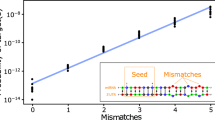Abstract
Genetic factors impact behavioral traits relevant to numerous psychiatric disorders and risk-taking behaviors, and different lines of evidence have indicated that discrete neurobiological systems contribute to such individual differences. In this study, we explored the relationship of genetic variants of the prodynorphin (PDYN) gene, which is enriched in the striatonigral/striatomesencephalic pathway, a key neuronal circuit implicated in positive ‘Go’ behavioral choice and action. Our multidisciplinary approach revealed that the single nucleotide polymorphism (SNP) rs2235749 (in high linkage disequilibrium with rs910080) modifies striatal PDYN expression via impaired binding of miR-365, a microRNA that targets the PDYN 3′-untranslated region (3′UTR), and is significantly associated to novelty- and reward-related behavioral traits in humans and translational animal models. Carriers of the rs2235749G allele exhibited increased levels of PDYN 3′UTR in vitro and had elevated mRNA expression in the medial nucleus accumbens shell (NAcSh) and caudate nucleus in postmortem human brains. There was an association of rs2235749 with novelty-seeking trait and a strong genotype–dose association with positive reinforcement behavior in control subjects, which differed in cannabis-dependent individuals. Using lentiviral miRZip-365 constructs selectively expressed in Pdyn-neurons of the NAcSh, we demonstrated that the Pdyn-miR365 interaction in the NAcSh directly influences novelty-seeking exploratory behavior and facilitates self-administration of natural reward. Overall, this translational study suggests that genetically determined miR-365-mediated epigenetic regulation of PDYN expression in mesolimbic striatonigral/striatomesencephalic circuits possibly contributes to novelty seeking and positive reinforcement traits.
Similar content being viewed by others
Log in or create a free account to read this content
Gain free access to this article, as well as selected content from this journal and more on nature.com
or
References
Abler B, Walter H, Erk S, Kammerer H, Spitzer M (2006). Prediction error as a linear function of reward probability is coded in human nucleus accumbens. NeuroImage 31: 790–795.
Belin D, Mar AC, Dalley JW, Robbins TW, Everitt BJ (2008). High impulsivity predicts the switch to compulsive cocaine-taking. Science 320: 1352–1355.
Blanchard MM, Mendelsohn D, Stamp JA (2009). The HR/LR model: Further evidence as an animal model of sensation seeking. Neurosci Biobehav Rev 33: 1145–1154.
Broyd SJ, van Hell HH, Beale C, Yücel M, Solowij N (2015). Acute and chronic effects of cannabinoids on human cognition- a systematic review. Biol Psychiatry 79: 557–567.
Clarke TK, Ambrose-Lanci L, Ferraro TN, Berrettini WH, Kampman KM, Dackis CA et al (2012). Genetic association analyses of PDYN polymorphisms with heroin and cocaine addiction. Genes Brain Behav 11: 415–423.
Clarke TK, Krause K, Li T, Schumann G (2009). An association of prodynorphin polymorphisms and opioid dependence in females in a Chinese population. Addict Biol 14: 366–370.
Cloninger CR (1987). A systematic method for clinical description and classification of personality variants. A proposal. Arch Gen Psychiatry 44: 573–588.
Cloninger CR (1999). A new conceptual paradigm from genetics and psychobiology for the science of mental health. Aust N Z J Psychiatry 33: 174–186.
Drakenberg K, Nikoshkov A, Horvath MC, Fagergren P, Gharibyan A, Saarelainen K et al (2006). Mu opioid receptor A118G polymorphism in association with striatal opioid neuropeptide gene expression in heroin abusers. Proc Natl Acad Sci USA 103: 7883–7888.
Fagergren P, Smith HR, Daunais JB, Nader MA, Porrino LJ, Hurd YL (2003). Temporal upregulation of prodynorphin mRNA in the primate striatum after cocaine self-administration. Eur J Neurosci 17: 2212–2218.
Fondevila M, Phillips C, Santos C, Freire Aradas A, Vallone PM, Butler JM et al (2013). Revision of the SNPforID 34-plex forensic ancestry test: assay enhancements, standard reference sample genotypes and extended population studies. Forensic Sci Int Genet 7: 63–74.
Frank MJ, Moustafa AA, Haughey HM, Curran T, Hutchison KE (2007). Genetic triple dissociation reveals multiple roles for dopamine in reinforcement learning. Proc Natl Acad Sci USA 104: 16311–16316.
Guitart-Masip M, Gimenez-Llort L, Fernandez-Teruel A, Canete T, Tobena A, Ogren SO et al (2006). Reduced ethanol response in the alcohol-preferring RHA rats and neuropeptide mRNAs in relevant structures. Eur J Neurosci 23: 531–540.
Heiman M, Schaefer A, Gong S, Peterson JD, Day M, Ramsey KE et al (2008). A translational profiling approach for the molecular characterization of CNS cell types. Cell 135: 738–748.
Hikida T, Kimura K, Wada N, Funabiki K, Nakanishi S (2010). Distinct roles of synaptic transmission in direct and indirect striatal pathways to reward and aversive behavior. Neuron 66: 896–907.
Hurd YL, Herkenham M (1995). The human neostriatum shows compartmentalization of neuropeptide gene expression in dorsal and ventral regions: an in situ hybridization histochemical analysis. Neuroscience 64: 571–586.
Janiri L, Martinotti G, Dario T, Schifano F, Bria P (2007). The Gamblers' Temperament and Character Inventory (TCI) personality profile. Subst Use Misuse 42: 975–984.
Jupp B, Dalley JW (2014). Behavioral endophenotypes of drug addiction: etiological insights from neuroimaging studies. Neuropharmacology 76: 487–497.
Jutras-Aswad D, Jacobs MM, Yiannoulos G, Roussos P, Bitsois P, Nomura Y et al (2012). Cannabis-dependence risk relates to synergism between neuroticism and proenkephalin SNPs associated with amygdala gene expression: a case-control study. PLoS One 7: e39243.
Kenny PJ (2014). Epigenetics, microRNA, and addiction. Dialogues Clin Neurosci 16: 335–344.
Kravitz AV, Tye LD, Kreitzer AC (2012). Distinct roles for direct and indirect pathway striatal neurons in reinforcement. Nat Neurosci 15: 816–818.
Kupchik YM, Brown RM, Heinsbroek JA, Lobo MK, Schwartz DJ, Kalivas PW (2015). Coding the direct/indirect pathways by D1 and D2 receptors is not valid for accumbens projections. Nat Neurosci 18: 1230–1232.
Lobo MK, Covington HE 3rd, Chaudhury D, Friedman AK, Sun H, Damez-Werno D et al (2010). Cell type-specific loss of BDNF signaling mimics optogenetic control of cocaine reward. Science 330: 385–390.
Lucas LR, Angulo JA, Le Moal M, McEwen BS, Piazza PV (1998). Neurochemical characterization of individual vulnerability to addictive drugs in rats. Eur J Neurosci 10: 3153–3163.
Malo MS, Abedrapo M, Chen A, Mozumder M, Pushpakaran P, Alkhoury F et al (2003). Improved eukaryotic promoter-detection vector carrying two luciferase reporter genes. BioTechniques 35: 1150–1154.
McClure SM, Berns GS, Montague PR (2003). Temporal prediction errors in a passive learning task activate human striatum. Neuron 38: 339–346.
McNeill E, Van Vactor D (2012). MicroRNAs shape the neuronal landscape. Neuron 75: 363–379.
Montague PR, Hyman SE, Cohen JD (2004). Computational roles for dopamine in behavioural control. Nature 431: 760–767.
Nikoshkov A, Drakenberg K, Wang X, Horvath MC, Keller E, Hurd YL (2008). Opioid neuropeptide genotypes in relation to heroin abuse: dopamine tone contributes to reversed mesolimbic proenkephalin expression. Proc Natl Acad Sci USA 105: 786–791.
Ortin A, Lake AM, Kleinman M, Gould MS (2012). Sensation seeking as risk factor for suicidal ideation and suicide attempts in adolescence. J Affect Disord 143: 214–222.
Piazza PV, Deminiere JM, Le Moal M, Simon H (1989). Factors that predict individual vulnerability to amphetamine self-administration. Science 245: 1511–1513.
Ray R, Doyle GA, Crowley JJ, Buono RJ, Oslin DW, Patkar AA et al (2005). A functional prodynorphin promoter polymorphism and opioid dependence. Psychiatr Genet 15: 295–298.
Saify K, Saadat I, Saadat M (2014). Association between VNTR polymorphism in promoter region of prodynorphin (PDYN) gene and heroin dependence. Psychiatry Res 219: 690–692.
Schaefer A, Im HI, Venø MT, Fowler CD, Min A, Intrator A et al (2010). Argonaute 2 in dopamine 2 receptor-expressing neurons regulates cocaine addiction. J Exp Med 207: 1843–1851.
Sheehan DV, Lecrubier Y, Sheehan KH, Amorim P, Janavs J, Weiller E et al (1998). The Mini-International Neuropsychiatric Interview (M.I.N.I.): the development and validation of a structured diagnostic psychiatric interview for DSM-IV and ICD-10. J Clin Psychiatry 59 (Suppl 20): 22–33; quiz 34-57.
Taqi MM, Bazov I, Watanabe H, Sheedy D, Harper C, Alkass K et al (2011). Prodynorphin CpG-SNPs associated with alcohol dependence: elevated methylation in the brain of human alcoholics. Addict Biol 16: 499–509.
Wei SG, Zhu YS, Lai JH, Xue HX, Chai ZQ, Li SB (2011). Association between heroin dependence and prodynorphin gene polymorphisms. Brain Res Bull 85: 238–242.
Xuei X, Dick D, Flury-Wetherill L, Tian HJ, Agrawal A, Bierut L et al (2006). Association of the kappa-opioid system with alcohol dependence. Mol Psychiatry 11: 1016–1024.
Yuferov V, Ji F, Nielsen DA, Levran O, Ho A, Morgello S et al (2009). A functional haplotype implicated in vulnerability to develop cocaine dependence is associated with reduced PDYN expression in human brain. Neuropsychopharmacology 34: 1185–1197.
Zhou L, Furuta T, Kaneko T (2003). Chemical organization of projection neurons in the rat accumbens nucleus and olfactory tubercle. Neuroscience 120: 783–198.
Zimprich A, Kraus J, Woltje M, Mayer P, Rauch E, Hollt V (2000). An allelic variation in the human prodynorphin gene promoter alters stimulus-induced expression. J Neurochem 74: 472–477.
Zuckerman M (1993). P-impulsive sensation seeking and its behavioral, psychophysiological and biochemical correlates. Neuropsychobiology 28: 30–36.
Zuckerman M (2002). Zuckerman-Kuhlman Personality Questionnaire (ZKPQ): an alternative five-factorial model. In: Raad BD, Perugini M (eds). Big Five Assessment. Hogrefe & Huber: Seattle, WA, USA. pp 377–396.
Acknowledgements
We would like to thank James Callens and Nayana Patel for their technical support, Dr Chloe Tessereau for assistance with the LD analysis and Dr Corey Watson for assistance with the analysis of ancestral informative markers. This research was supported by Icahn School of Medicine at Mount Sinai Fund (YLH), NIH DA15446 (YLH), Centre hospitalier de l’Université de Montréal Research Fellowship Award (DJA), NIH T32 5T32GM062754 (SAA), NIH T32 DA007135 (MMJ and MM) and UNCF/Merck Dissertation Fellowship (SAA).
Author information
Authors and Affiliations
Corresponding author
Additional information
Supplementary Information accompanies the paper on the Neuropsychopharmacology website
Rights and permissions
About this article
Cite this article
Egervari, G., Jutras-Aswad, D., Landry, J. et al. A Functional 3′UTR Polymorphism (rs2235749) of Prodynorphin Alters microRNA-365 Binding in Ventral Striatonigral Neurons to Influence Novelty Seeking and Positive Reward Traits. Neuropsychopharmacol 41, 2512–2520 (2016). https://doi.org/10.1038/npp.2016.53
Received:
Revised:
Accepted:
Published:
Issue date:
DOI: https://doi.org/10.1038/npp.2016.53
This article is cited by
-
Sex differences in neural mechanisms mediating reward and addiction
Neuropsychopharmacology (2019)



